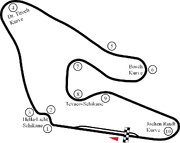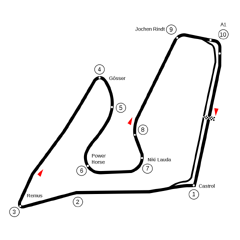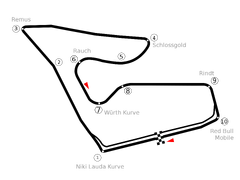The Red Bull Ring (formerly the Österreichring and the A1-Ring) is a motor racing circuit near Spielberg, Austria which has been used to host the Austrian Grand Prix on 30 occasions, the latest in 2018. Since opening in 1969, the circuit has undergone major layout changes in an attempt to improve safety. It was removed from the Formula One calendar in 2003 and lay dormant for several years. However, the circuit was acquired by Red Bull owner Dietrich Mateschitz and reopened in 2011. It has since hosted rounds of the DTM and Formula 2 championships in 2011. The Austrian Grand Prix returned to the F1 calendar in 2014.
History
Österreichring

The Österreichring with the Hella-Licht Schikane.
The local auto club felt that Austria belonged on the Formula One map. But after running two events at the nearby Zeltweg Airfield, a proper track was desperately needed. A plot of land was found about two km north, in the foothills above the airport. Making full use of the available space and terrain, a 5.9 km circuit was laid out, with only seven real corners. At no point on the track did a Formula One car have to shift below third gear, and laps speeds were comfortably above 200 km/h.
A1-Ring

The circuit, as the A1-Ring.
Red Bull Ring

The Red Bull Ring, unchanged in design from 2003.
Starting from the 2017 Austrian Grand Prix, the kink after Turn 1 was recognized as Turn 2 by the FIA, after MotoGP described it as Turn 2 during their races at Austria.[1]
Circuit Layouts
1969-1975
The original layout was 5.911 km/3.673 miles long. An irregular horseshoe, it had seven sweeping corners and three gentle kinks, making it a horsepower track but still requiring grip and stability. The pit straight was almost a full kilometer long, starting as downhill, flattening out past the pits, and then heading sharply uphill. At the end was the 45° righthander known as Hella-Licht, not quite flat out, but the fastest turn on the track. Another straight of similar length wound slowly uphill, with a flat out left kink known as Flatschach near the end. The cars had to back off for the uphill Dr. Tiroch Kurve, turning right almost 180°.
Just after the bend, the track crested at it's highest point, more than 100 meters/328 feet higher than the pits. This is on the Valvoline Gerade, the third and final long straight of the course. The track now makes a long downhill run. The fastest part of the track was at an unnamed left kink leads directly into Bosch Kurve, a fast, banked, sweeping and quite dangerous righthander of more than 180°. A short downhill straight led into a pair of comparatively slow lefthanders in a gulley, known collectively as the Texaco Schikane, and almost immediately through an unnamed and gentle uphill right. Another short straight named Raiffeisenhügel incorporates a noticeable climb at the midpoint, then downhill to the downhill and sweeping Rindt Kurve, leading onto the pit straight.
1976
During practice for the 1975 race, Mark Donohue had a tire disintegrate heading into the Helle-Licht corner. His head struck the support post for a sign, and the next morning he died of cerebral hemorrhaging. For 1976, Helle-Licht was slightly rebuilt, turning the sweeper into a sharper kink, adding runoff room and reducing the track length by one meter.
1977-1987
The data from the 1976 even showed that the slightly redesigned Helle-Licht corner had not reduced the safety risk, so for 1977 the corner was rebuilt entirely. The corner was now a right-left-right chicane, and the fastest bend in the circuit was now the slowest. Most of the drivers were not happy with the change, but the change was made largely at the instigation of Goodyear, who had lost an expensive lawsuit to Donohue's widow. The track now measured 5.941 km/3.692 miles.
Race winners
Notes
- ↑ 1.0 1.1 Wood, Ryan (5 July 2017). "FIA amends Red Bull Ring's corner numbers". Motorsport Week. https://www.motorsportweek.com/news/id/15176. Retrieved 10 July 2017.
| V T E | ||
|---|---|---|
| Circuits | Zeltweg Airfield (1963–1964), Red Bull Ring (1970–1987, 1997-2003, 2014-present) | |
| Races | 1964 • 1965–1969 • 1970 • 1971 • 1972 • 1973 • 1974 • 1975 • 1976 • 1977 • 1978 • 1979 • 1980 • 1981 • 1982 • 1983 • 1984 • 1985 • 1986 • 1987 • 1988–1996 • 1997 • 1998 • 1999 • 2000 • 2001 • 2002 • 2003 • 2004–2013 • 2014 • 2015 • 2016 • 2017 • 2018 • 2019 • 2020 • 2021 • 2022 • 2023 | |
| Non-Championship Race | 1963 | |
| Red Bull Ring was previously called Österreichring and A1-Ring. | ||
| v·d·e | Nominate this page for Featured Article |

